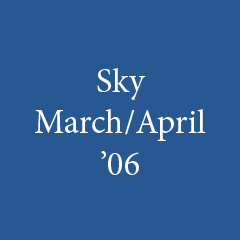Circumpolar Constellations
Circumpolar Constellations
What’s the big deal with the north star? It’s no bigger than an average star. It’s got a very small constellation attached to it, the little dipper or little bear, called Ursa Minor. The big deal is it’s the only star in the sky that stays in one spot making it very handy for orientation and navigation.
In the old days, and even when lost in these days, it’s a guide star for finding your way because it stays in the same spot. Actually the stars really don’t move, the apparent movement is because the earth spins. So right above the pole, in our part of the globe, the star closest to that point in the sky is still and every other star swings around it. Tight circles close in and wider and wider on out. The north star or pole star is really the star Polaris. In Plato’s time KIochab, in the little dipper, was the pole star, about 400 B.C. When the pyramids were being built 4-5,000 years ago it was Thuban, in draco, that was the pole star. 2,4 and 6,000 years from now King Cepheus will host the pole star as different stars in his cap. Get this: in 14,000 AD the north star will be Vega, in Lyra, not even a circumpolar star for us now! So you see there’s a bit of a wobble and evolution in the our solar system.Actually circumpolar constellations are relative to your location. I’ll be talking about our position on the planet where these constellations never set but spin around Polaris all night and all year. That’s the definition of circumpolar: that they don’t set [disappear]. Viewed from the equator, for instance, there are no circumpolar stars at all. These circumpolar constellations swing around and help you find the Polaris [#7]. One of the most well known and pretty large constellations is the Big Dipper [#1], or the big bear, technically called Ursa Major. The dipper’s two pointer stars are the edge of the dipper away from the handle. We use them to point to Polaris. I’ve added a dotted line in the illustration to indicate this. Depending on where you are, like mountains, deserts, etc. and the season you’re looking, the dipper may be not only the most well known but best way to find the north star. However you may be in mountains at a time of year when the dipper is low [like now] and out of sight to you. When that happens I’ve got an alternative finder constellation for you. I’ve used it for years. It’s Cassiopeia [#2], the “W” or “M”, depending on where it is around the Polaris. If you trisect the wider of it’s two angles, that is divide it into three pieces of pie, mentally, the outer line you needed to do that will lead you to Polaris too. And if you’ve got the tail of the big dipper showing, it will line up with it’s end star for confirmation. I’ve shown this on the illustration too. Since these constellations are opposite each other, one of them is almost always visible. Hopefully you’ll never be lost but just have fun with this information.Once you can find the Polaris [7], our pole star, or north star, you can orient yourself to the sky and to the land around you. Facing north, looking at Polaris, to your right is east, left west and behind you is south. If you were lost and you knew which way was towards home you could find a mountain or other land mark to walk toward the next day and know you were going towards home not in a circle. Some warm night go out and find north. Perhaps find some family or friends and a couple of chairs and sit down to contemplate and explore this significant region of the sky. If you have my illustration before you you will find what we’ve been talking about above. The rest of it goes like this: The dipper [#1] is part of the bear, Ursa Major. I picture the legs going out away from the north star from the “dipper” with three sets of two making three of his feet. The handle is a long tail [not very bear like]. Notice how the little dipper [#4] is much the same shape as the big dipper but smaller. It’s claim to fame is, of course, the pole star, now our Polaris which is the very end of it’s handle. I don’t really see much of a bear. Draco [#5], the dragon, is huge but dim and winds around the little dipper. His head that trapezoid, a wonky square, and is what I look at. Further around Polaris is Cepheus [#3] , the king to Cassiopeia the Queen. He’s like a house with a steep roof some have called his cap. The “box” being his face. Some see a pigtail in one of the corners. Go figure.There’s one more and I don’t even know it, it’s so dim it’s Giraffe [#6] between Cassiopeia and Ursa Major, kind of opposite the little dipper from the north star.By the way, hope you enjoyed the wonderful Perseid meteor showers peak early morning on August 13th as it is each year like clockwork. Did you try anytime the night of the 12th or early morning of the 13th for some meteors? I found 8 in about 10 minutes two were really beautiful. A friend saw 10.The full Moon in September is a Harvest Moon on the 26th right after the September equinox on the 21st. It’s full also on the 26th of October and is called the Hunter moon.




